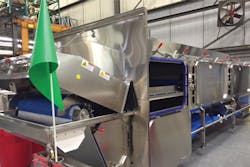Laitram Machinery, a leading manufacturer of seafood processing equipment, is a wholly owned subsidiary of Laitram LLC, which is based in Louisiana and has nearly 2,000 employees worldwide. For years, the company implemented continuous improvement efforts utilizing traditional lean tools. However, as Laitram sought to expand into industries beyond seafood, the management knew improving its processes flow was key to capitalizing on future opportunities.
After being introduced to operational excellence, which is when "Each and every employee can see the flow of value to the customer and fix that flow before it breaks down," the company realized how it could be doing things better. It set a goal of operational excellence, and Jeffrey Corbin, operations manager of Laitram Machinery, toured other companies that had successfully achieved operational excellence, including Hyperthem. It then kicked off its initiative with a training program to teach personnel how to design self-healing, end-to-end value stream flow throughout the organization that would free up management. Today, the principles of operational excellence Laitram employees learned drive every aspect of their work — and real results for the company.
Moving from tools to principles
One of the first things Laitram did was train employees on the importance of applying the principles for designing flow in the company’s operations rather than simply using traditional lean tools. Corbin likens tools to a prescription for an ailment that may not exist in a particular environment or whose cause may be different. He believes principles, however, are foundational.
"You can’t just take a pill and hope it will make things better," says Corbin. "Instead, you have to train your team on how to apply principles based on the particular issues they face."
Laitram team members were taught these eight principles (which must be applied in order) of operational excellence:
- Design lean value streams.
- Make lean value streams flow.
- Make flow visual.
- Create standard work for flow.
- Make abnormal flow visual.
- Create standard work for abnormal flow.
- Have employees in the flow improve the flow.
- Perform offense activities.
By having principles to guide their actions, each employee identifies ways to do things better. "They’re grabbing hold of the ownership. ‘Self-management’ is a core component of our organizational model," Corbin says. "Employees are responsible for owning and delivering their own work and having principles can help them solve problems in their own unique environments."
Putting principles into action
All Laitram’s teams, from the factory floor to its offices, began to apply the first four principles to design lean value streams and make dramatic improvements. For example, Laitram’s assembly area was previously able to progress from a shell to a completed cooker in five days, at which time the machine would sit for several weeks until parts arrived for the next step. Now, it starts an assembly only when all the required parts are on hand to maintain continuous flow.
Because of improvements in production, Laitram began applying some of the same concepts of flow to the installation process. Previously, for example, parts would arrive at a customer’s facility in seven different containers across multiple days. As a result, the customer did not know which container to open first or how to unload the equipment based on the order of the build.
"Now, our engineers, commercial team, service team and field team go through the drawings together and talk about how to [carry out] the installation and also how it’s going to be packed in the containers," says Corbin. "The parts arrive at the right time, so customers can build right away and not have to store certain materials and wait. So we’ve taken the end game and driven it back into our production schedule. That’s end-to-end value stream."
Laitram’s support organizations, such as the machine shop that provides machined products for Laitram Machinery and other Laitram companies, have also undergone a transformation in flow. In the order processing department, supervisors, the scheduler, the planner and others were previously involved in processing orders but still could not complete them in time. The company looked at the data: How many orders were coming in every day, and how many were repeat versus new? Using this data, it created discrete workflow cycles — the preset rate at which information flows between different work areas or departments along a fixed physical pathway — for processing them.
"For five hours a day, orders can come in. Then we have a cut-off time when we process things," explains Hans Ruoss, machine shop general manager. "Then at a certain time every day, we have a meeting about orders that come in. If they’re repeat orders, they can enter the process. If they’re new, we have to see where they fit on the schedule, make sure we have material and so on. It’s a different flow. Then they’re consolidated after that process. Next, they go to routing; then we run material requirements planning.
"Workflow cycles have enabled us to move information forward. The litmus test [was] what things [looked] like when our production planner came back from a two-week vacation," says Ruoss. "The only orders on her desk were the ones that came in that day."
Balancing variation
One of the biggest challenges Laitram consistently faced before beginning its journey to operational excellence was a seasonal sales period for its highly customized machines, one into which it had little visibility until the end of the season. That meant Laitram had a highly variable volume and a shortened window for processing orders. If it could not produce equipment in time, the company would have to forego the opportunity until the next year.
When Corbin joined Laitram, the response to this issue was to increase man hours. However, arming the team with principles to improve its throughput and use visual cues to tell if equipment was on time enabled Laitram, instead, to reduce man hours and still increase business.
"Last year, we took in and successfully executed orders we may have previously walked away from or would have pushed to the following year," says Corbin.
Another issue for Laitram was high variability in its product mix. While every machine at Laitram continues to be different, one thing the company is moving away from is custom manufacturing. Now, it uses configurator software, and as it designs a new feature, it maintains it in a database so it can reconfigure it rather than starting over each time. Every piece of equipment that flows through may be different. For example, one could be for cooking shrimp and another for blanching vegetables, but because of the way Laitram restructured the flow of information through engineering, it can efficiently transition to a new piece of equipment.
"It’s not cost-effective to be custom, so we have a modular approach to our equipment that allows a customer to buy a particular piece of equipment with certain options," says Corbin. "It’s about doing a mixed model efficiently."
From operations to offense
Once it applied the first four operational excellence principles to design lean value streams throughout the organization, Laitram began applying the next four to shift the culture from one focused on never-ending continuous improvement to a company with a goal of business growth and leapfrogged its performance in just two years.
Because of the improvements in flow, Laitram can now spend time on identifying ways to capitalize on new opportunities, including those in multiple industries. Originally, for example, its shrimp equipment only supported one market. After applying the operational excellence principles, shrimp graders are also designed to grade chicken and cookers can also be used for crab, lobster, vegetables and nuts.
"We took a core piece of equipment to adjacent markets to see if its capabilities were applicable," explains Corbin. "But you need time to figure that out because the requirements are different. And enabling our employees to see when flow begins to be abnormal and fix it on their own without management has given us the time to look at new applications for our technology."
In fact, one of the primary reasons Laitram sought to implement autonomous value stream design was to free up operations management, the goal of operational excellence.
"Giving employees foundational principles they can use to guide their decisions reinforces that they’ll make decisions that are aligned with what I would do," says Corbin. "While every situation is different, if workers apply the principles in a uniform fashion, it eliminates the need for management intervention."
With leaders now able to step away from daily operations, they can work on activities to grow the business.
"The first year and a half I was here, I never visited a customer facility," says Corbin. "But this year, I went to visit nut plants for a week since nut pasteurization is a new market for us, and I went to an installation in Norway to see how the customer uses our equipment and bring back ideas about improvements we can make to resolve installation and operational issues. And I have the confidence to be away from the factory because the employees know what to do since they operate with a set of principles."
Laitram is also able to meet its deadlines, giving its sales team the ability to sell with confidence. Previously, the production team would have a hard time delivering against the promised dates, leaving the salesforce to explain the delays.
"It’s hard to instill confidence in your customers that you’re going to be there and to convince your sales team that they can keep selling if you can’t execute," says Corbin. "Today, if our staff can sell it, we can build it, and we can fit it in the schedule to match the customer’s needs. We’re even asking some of our customers if they can take shipments early. Now we get more business because we’re more responsive.
"Right now we have the engine set up to get new market opportunities."
Kevin J. Duggan is a renowned expert in applying advanced lean techniques to achieve operational excellence and the author of four books on the subject: Design for Operational Excellence: A Breakthrough Strategy for Business Growth; Creating Mixed Model Value Streams; Operational Excellence in Your Office: A Guide to Achieving Autonomous Value Stream Flow with Lean Techniques; and Beyond the Lean Office: A Novel on Progressing from Lean Tools to Operational Excellence. As the Founder of the Institute for Operational Excellence, an educational center on operational excellence, and Duggan Associates, an international training and advisory firm, Duggan has assisted many major corporations worldwide. He is a frequent keynote speaker, master of ceremonies and panelist at international conferences, regularly contributes to industry publications, and lectures graduate students at business schools in the U.S.


